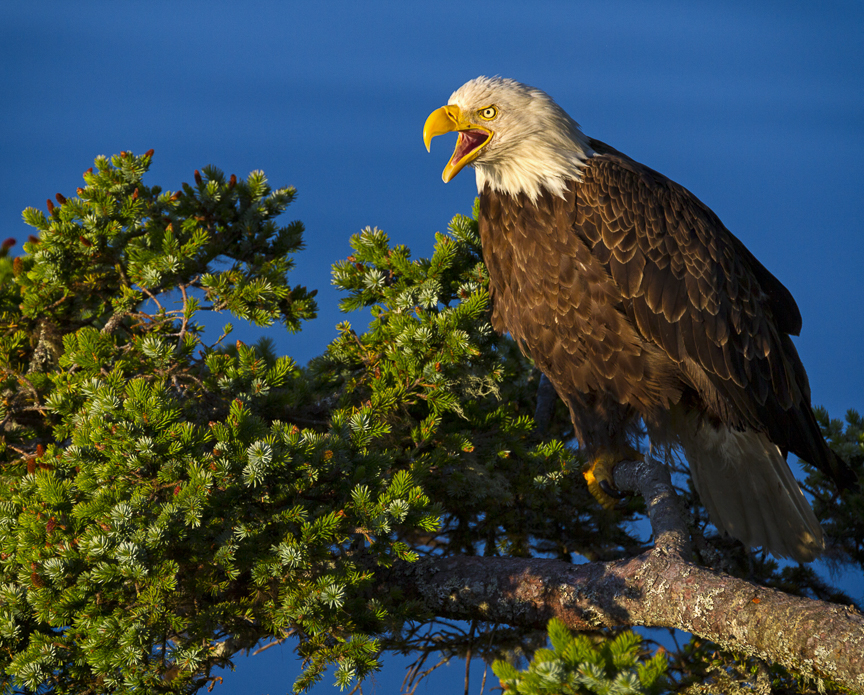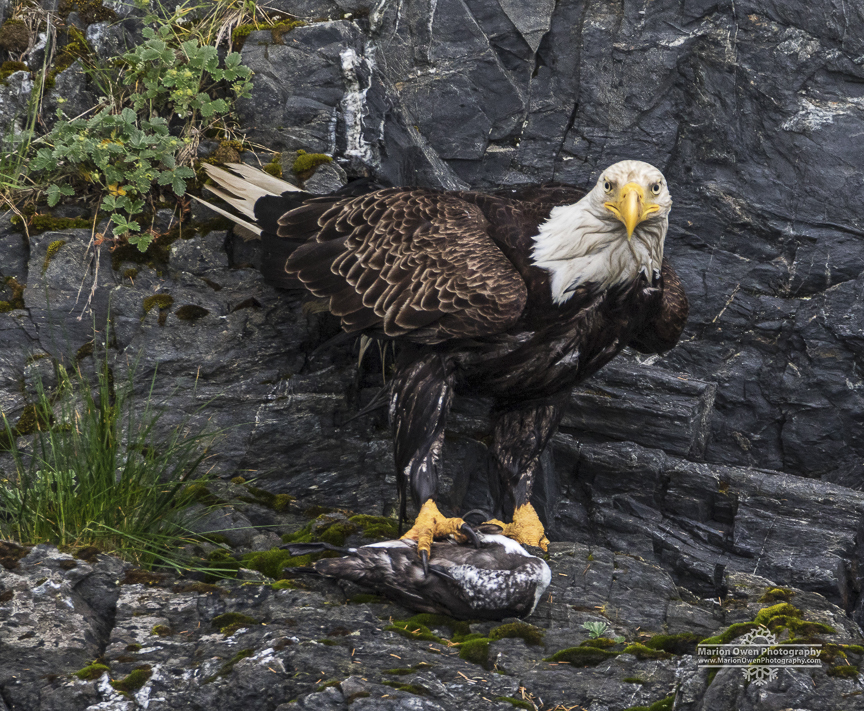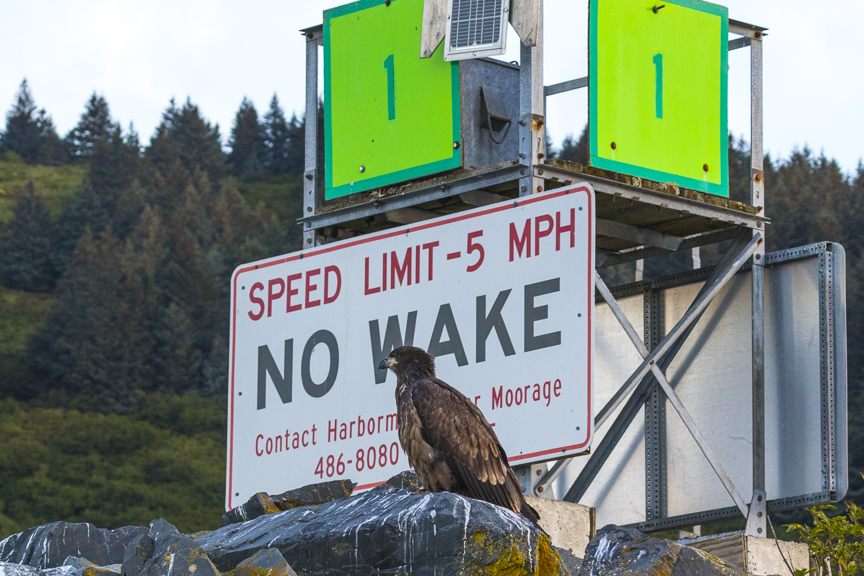Eagles around Kodiak are plentiful as crows during the winter. Perched shoulder-to-shoulder with their fellow raptors, they haggle over fish scraps, those leftover bits that fall below seafood processor radars. In summer though, these large birds of prey embrace a parental role by taking up residence in lofty nests to raise chicks.
It’s this parental role that we witnessed as rare scenes of eagles in action. From June through August, I documented their lifestyles during photo walks and from the deck of our boat during wildlife cruises and wildlife viewing trips. Now it’s almost September, and I can finally enjoy some free time to process photographs. I selected a few images to share with you here:
Eagle baby food
In early July, I picked up vanilla latte at Java Flats and drove out the road with several photo friends to Pasagshak (puh-SAG-shak), a large U-shaped bay about 50 minutes south of town (Kodiak) to check on this nest. Lo and behold, the parents were actively feeding their only child. We set up our tripods and watched the adults shred portions of mystery meat and carefully present it to the eager chick.
For me, the act of feeding the young bird was special to see, but I was drawn to the adults’ talons and how deftly he/she maneuvered the prey on the floor of the nest to get just the proper morsel for junior.
I thought about my father-in-law, who graduated from Kodiak High School in the 1940s. He, like many Alaska residents in the day, profited from the territory’s bounty program: Since bald eagles fed on salmon, they were considered a menace, and so for each pair of talons brought in, you were paid $1.50; big money back then.
Got coffee?
One morning in July, this female eagle (females are about 25 percent larger than males) flew in a circle and then perched on a tree limb above the beach in plain view of our deck. Our B&B guests were delighted. We sipped coffee and listened to this disgruntled eagle scream at the world. She looked, angry, as if crying, “Where’s my coffee?”

When eagles become ducks
I’ve photographed bald eagles in many scenarios: Feeding on garbage in a landfill and yanking bits of fish from a net on the back of a fishing boat. But diving in the water and then swimming to shore?
We spotted this eagle from the boat, swimming–no, rowing– toward the shore. We assumed he’d nabbed a salmon, which is normal. Now bald eagles are the second largest North American bird of prey, (next to the California Condor), and carry a 6-foot-plus wingspan. It wasn’t until he scrambled up the rocks and turned around to look at us, that we noticed he was clutching a young Common Murre.
See the feathers around the head and along the leggings? They look more like carved wax.

A week later, we observed an entire strike-and-kill sequence. An adult eagle swooped down from a rocky outcropping and plunged, talons first, into a patch of kelp. Then he started making his way toward the beach, scooping his wings and swinging them forward, like a swimmer doing the butterfly stroke.

Suddenly, a long, slender black beak popped up behind the eagle. A murre! As the eagle jerked itself toward the shore–a good 100 feet away–the murre fought for his life. He flailed, poked at his captor, and yanked his upper body side to side in an effort to free itself from the talons’ grip.
Once on the beach, the eagle dragged the murre onto the rocks and clamped its beak across the murre’s head. Finished. It was hard to watch it all unfold, though we realized it was an extraordinary event to witness. We started backing up the boat as the eagle pulled and spit out feathers…
How do you eat this thing?
Touring around the bay at low tide one morning, Marty and I saw the white, “golf ball” head of an eagle bobbing up and down on a stretch of beach. It was feeding on something but we couldn’t make out what it was. So we maneuvered the boat closer…
Amazing. Here was an eagle trying to eat an octopus. This was certainly a first for us. Perhaps for the eagle, too. The Giant Pacific octopus by the way, (named by ancient Greeks meaning “eight foot”) is the word’s largest octopus species, a challenge for the eagle.

Grab. Pull. Stretch. Repeat. It was almost comical. The eagle would lift up part of the mantle, let go, and then try for an arm. (Funny, eagles aren’t even listed as a predator). Alas, the tide was going out, so we had to leave, but I’ll never forget the look on the eagle’s face.
Flying the coop
For the last photo in this essay, I though I’d leave you with a chick update. In June, in one of the nests we monitored on our almost daily boat tour, we spotted three chicks, a high number, according to Cornell Lab or Ornithology’s fabulous online directory, The Birds of North America. Bald eagles often have two, sometimes three, but rarely four chicks. By mid-August, all three birdlettes had fledged and were still alive.
The other day, while returning to the boat harbor, we spotted one of the chicks in front of the “No Wake” sign at the breakwater entrance. I caught myself feeling a little motherly. “My, how you’ve grown,” I thought.
Maybe the eagle’s gourmet diet had something to do with it.

Fascinating article and the pictures are gorgeous as always.
Glad you enjoyed the photos and stories behind them. It was fun putting it all together. Cheers and blessings, Marion